More History
Explore A Rich and Fascinating History
The Albury Heritage Trail takes the region's history out of books and places it in the community providing an accessible and interesting glimpse of what made the region what it is today.
The sites in the heritage trail include various buildings in Dean Street, the Albury Railway Station, the Botanic Gardens, Hume Dam, the War memorial on Monument Hill, the Crossing Place/Hovell Tree, Saint Matthews Church, the Albury Pioneer Cemetery, the Catholic Precinct, and the former Farmers and Graziers Woolstore.
All-weather interpretive boards and a brochure detailing the location and historical significance of the sites provides the basis for the trail. People have the option of walking the central Albury section or driving it in its entirety.
The following is an extract from an article written in The Border Post by Albury's 'founder' Robert Brown (1810 - 1879):
"When I settled down nearly under the shadeless tree on which Mr Hume carved the name Hume River on November 17 1824, I could little imagine that so rapid a transformation would take place in a few short years, my only companions a few blacks, the kangaroo, the emu, the native dog. Now Albury can boast of its newspapers, fine buildings, steam mills, its churches, bank, court house etc."
Dean Street Group
Encompassing the Old Courthouse (1860), Post Office (1875), former Albury Town Hall (1908) - Regional Art Gallery and original Crown Lands Office (1860's) - Burrows House
Old Courthouse
Designed by Colonial Architect Alexander Dawson and completed in 1860, the Old Courthouse is classified by the National Trust. The builder was Thomas Allen, of Albury, who used local grey granite for the Palladian-style facade. It retains an iron-railed dock, painted coat of arms above the bench and a Press gallery on which journalists have traditionally carved their names. John Roper (a member of Leichhardt's 1844 expedition) was the first Clerk of Petty Sessions in 1847.
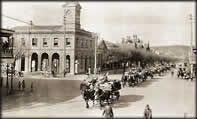
Post Office
Built in 1875 by local builder, Alexander Frew, around an earlier structure. An imposing country post office having good civic architectural qualities which makes a suitable entrance to the other civic buildings in Dean Street in terms of style, scale and height. Frew included an arcaded verandah on Kiewa Street, which has since been filled in. The present open verandah is part of a later extension. The truncated clock tower was added in the 1920's and built of timber disguised as masonry.
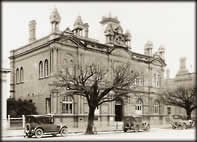
Former Albury Town Hall
Now the Regional Art Gallery, the Town Hall was a boastful statement of civic pride. Built by local artisans with money borrowed from local institutions it showed the 'energy, enterprise and grit' of a district recovering from harsh times at the beginning of the 20th Century. A good example of the Federation Free Classical style of Town Hall which was built at a time when the district was beginning to boom as a result of closer settlement.
Burrows House
Formerly the Crown Lands Office, Burrows House has served many purposes since it was built in the 1860's. The City Council had offices there in the 1960's and later converted it to community use under the title of Burrows House, honouring Percy Burrows, the flour mill owner who was Mayor in 1916 when Albury's electricity supply was opened. The facade is decorated with Greek Revival details in stuccowork while the side facing the courthouse has a two-storey verandah and colonnade.
Heritage Trail
Albury Railway Station
The Station was a confident colonial government's territorial claim to counter the intrusion of Victorian railways into the Border District in the highly competitive 1870's and 1880's. Its designers seemed to be declaring, "Look on this monument, Victorians, and despair".
One of Australia's most important railway stations, it was built in 1881 as the transfer point on the break of gauge railway between Sydney and Melbourne. Designed in the grand Italianate manner under the direction of NSW Government Railways Chief Engineer John Whitton, it is a symmetrically arranged building over 300 metres in length.
The covered platform is one of the longest in Australia with the other being Flinders Street Station in Melbourne.
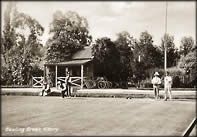
Albury Botanic Gardens
Albury City's Botanic Gardens were opened by Mayor William (Coffin) Jones in 1877. It was originally laid out in the formation of a Union Jack (all straight lines). Mr J E R Fellowes was curator of the Gardens for 36 years during the 20th century.
Covering 10 acres, the Gardens contain a fine collection of trees, shrubs and flowers as well as an historic monument to Hamilton Hume and a rotunda commemorating Albury's first settler, Robert Brown. The gates commemorate Robert Wilkinson, a draper who was mayor in 1903 - 05.
The first trees, the 'Elm Avenue', were planted in 1877. The tallest tree is a Queensland Kauri, reaching 46metres.
The Gardens were also the site of Albury's first bowling greens, which were laid in 1905 at the Western end of the Gardens.
A jewel in central Albury, the Botanic Gardens has won many State awards.
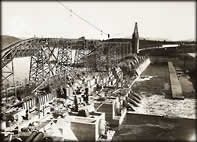
Hume Dam
Lake Hume was hailed alongside Sydney Harbour Bridge, as one of the mightiest Australian structures of the inter-war years. It was one of the first great inter-government co-operative projects facilitated by Federation.
At its peak the work employed 1000 men and nine lives were lost. Horses, steam engines and much manual labour were used, including the hand-to-hand passing of rock.
The dam's purpose was to assure an unceasing water supply to present and future irrigation districts and to the towns along the Murray from Albury to the sea, and to Adelaide.
Originally the dam was completed in 1936 had a capacity of 1522 gigalitres, but between 1950 and 1961 further work increased this to 3038 gigalitres by erecting gates above the dam. A hydro-electric power station was added in 1957.
The dam is located 2225 km's from the Murray mouth and is formed by a structure 1616 metres wide.
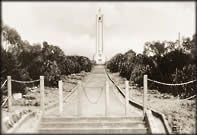
Monument Hill/War Memorial
In 1915 a visiting town planner, Charles Reade, proposed plans to erect a monument on the western hill to memorialise soldiers fallen in combat. The subsequent siting of a War Memorial on the hill specially acquired by Albury Council at the end of Dean Street remains a good example of bold and imaginative town planning.
Designed by Louis Harrison and built by Tom Bartleson, the Monument was opened on Anzac Day, 1925 by General Paine.
One of the few towers erected as a World War I memorial, it is regarded as one of the best known War Memorials in Australia. The visibility of the monument was seen as a vital part of it's meaning when the site was selected.
The significance of the site is further enhanced by the presence of the Memorial Bowl nearby, which was erected as a World War II memorial.
The "Crossing Place"/The Hovell Tree
Originally at a point near the end of Hume Street, the 'Crossing Place' extends through the riverside parks to the Union Bridge and includes:
The Hovell Tree
Marked by Captain William Hovell in 1824 and is the first evidence of the presence of whites in Albury. Captain William Hovell and Hamilton Hume were the first white men to see the Murray River. The Hovell Tree, marked by the explorer on November 17, 1824 was flanked by another tree marked by Hamilton Hume which was destroyed by fire in the 1840's. Hume and Hovell travelled from the Yass area and after crossing the Murray River where Lake Hume now is, they crossed the Mitta Mitta River and proceeded to Corio Bay, Westernport.
The Turks Head Hotel
This building was built as a public house at what developed as the entry to Albury after the Union Bridge was opened in 1861. It was known as the Union Bridge Hotel and then the Turks Head Hotel before it was delicensed in 1921 and became a boarding house, and finally a Museum in the late 1950's.
In the late 1870's the Turks Head Hotel organised sports to celebrate Easter and the Prince of Wales birthday. Visitors could play skittles indoors or quoits. They could compete in hop, step and jump or in vaulting contests. They could run footraces over 100, 200 or 300 yards. As is still the case, children enjoyed the lolly hunt.
The 19th century wharf site and the site of Robert Brown's store (1836)
One of Albury's earliest pioneering families was the Huons. Two Huon brothers, Charles and Paul, arrived in early 1836. Another of the Huon brothers, Aime, arrived later in 1836 with his brother-in-law, Robert Brown. The Huons persuaded Brown to settle beside the 'Hume River' and open a store for travellers.
Shortly thereafter, Hawdon, Hepburn and Gardiner took the first cattle overland to Melbourne via Robert Brown's 'Crossing Place'. It was the 'Crossing Place' on the 'Hume River' that made Albury an ideal site for a town.
Brown's store was near the Hovell Tree, which overlooks the 'Crossing Place'. It was here that Brown later began a ferry service which serviced the squatters, drovers, draymen and other overland travellers, who by 1839 were averaging one a day.
St Matthews Church
Arguably Albury's best item of architectural and historic interest. Combines Edmund Blacket's original west wall and tower base of 1857-59, William Boles' chancel completed in 1876 and the rebuilt church designed by Ian O'Connor after the church was gutted by fire in September, 1991.
Edmund Blacket was the original designer of the church. He was a noted Colonial Architect who also designed Sydney University and St Saviour's Cathedral in Goulburn.
It is a tribute to the parish and to the hundreds of people who made the refurbishment possible - perhaps the last time a 'Gothic' Church would be rebuilt.
Albury Pioneer Cemetery
The NSW National Trust in 1988 classified the Cemetery as an outstanding item of environmental heritage that records much of the history of Albury.
The Cemetery boasts an exceptional range of marble and granite monuments and interesting ironwork. Some of this ironwork was locally made, notably by John L. McEachern and L Schneider.
This is truly a graveyard for people of all nations. Graves of people from many countries including England, Scotland, Ireland, Wales, Germany, Ukraine, Latvia, Syria, India and China as well as from Australia, are within the cemetery.
The Albury Pioneer Cemetery was opened in 1860 and burials are still conducted there on a limited basis.
The Catholic Precinct
Unique group of buildings, including St Patricks Church with its cycle of 42 stained glass windows made by Australia's first stained glass artist, John Falconer, in 1872. Also the Convent (1870), Sacred Heart Chapel (1879), Christian Brothers College (1885), the presbytery (1905) and brothers monastery (1917).
St Patricks Church was designed by John Gordon, under the direction of the parish priest, Dr Michael McAlroy, and built by James Walsh. Dr McAlroy died in 1880 and is buried behind the main altar.
The Church is made by local bricks and stone with pitch pine in the trusses and Welsh slate on the roof. The stone used in the window and door dressing is purple sandstone, which was discovered at Tabletop just prior to the church being built.
Old Farmers and Graziers Woolstore
The old Farmers and Graziers Woolstore was formerly Australia's largest inland Woolstore. By 1962 the floor space totalled 6.8 acres and could display 12,000 bales of wool.
Originally the Woolstore had a 104m frontage to Smollett Street, excluding the Smollett Street corner. The Smollett Street corner of the building was formerly a hotel, theatre then retail outlet prior to being incorporated into the Woolstore building in 1933 by Louis Harrison, who also designed the Albury Monument.
A reminder of the importance of the wool trade in terms of the development of the region and country.
Smollet Street bridge
Completed in 1888, the Smollett street bridge over Bungambrawatha Creek is one of only two steel arch bridges in NSW (the second one is the Sydney Harbour Bridge). The bridge was designed by Mr John A McDonald, Assistant Engineer for Roads and Bridges, under the supervision of Mr W C Bennett, MICE, Engineer-in-Chief. The whole of the ironwork was manufacture in the colony for £737. The bridge was built by a local, Mr Frank Romero for the contract sum of £1227, under the supervision of Mr E O Bowyer Smyth, the local road superintendent. The bridge opened for traffic on Monday September 17, 1888.
History content credit:
The Albury Region Heritage Trail is a City of Albury initiative and was made possible with support from the Federal Government Centenary of Federation Fund.
Acknowledgments and thanks are extended to: Mr Howard Jones, Dr Bruce Pennay, Mr Gerald Curtis, Mrs Helen Livsey, The Border Mail and Albury Historical Society.
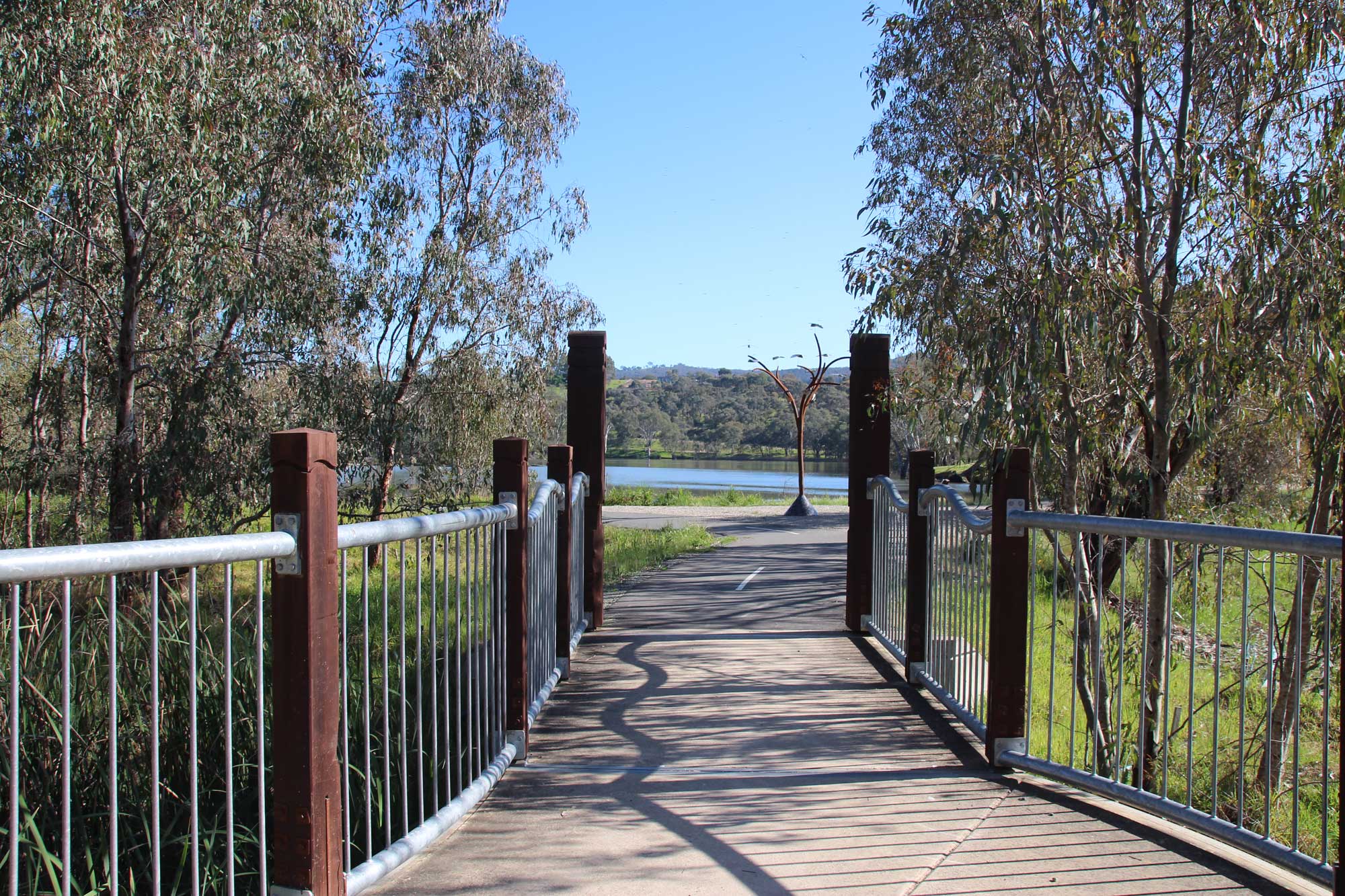












Albury Wodonga Australia Social Pages